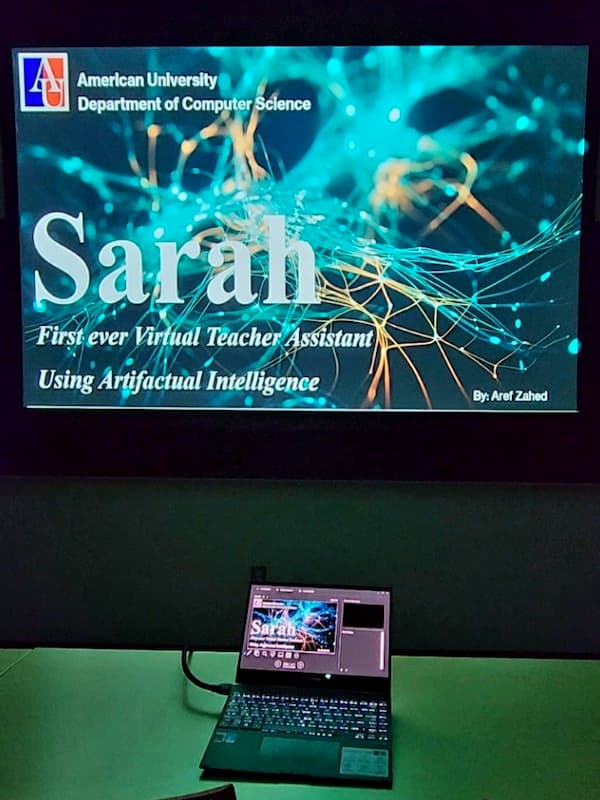AI Virtual Teaching Assistant “Sarah” Makes Her Debut at American University

Last year, American University launched Spidey, an AI robot who can move, speak, recognize faces, and answer questions using ChatGPT technology. This year, Spidey was joined by Sarah, an AI teaching assistant that participates in the teaching process by responding to her name, “listening” to questions, and using ChatGPT and Google search engines to reply and project answers on a screen.

Both Spidey and Sarah were developed by Computer Science Professorial Lecturer Aref Zahed, who is incorporating Sarah as a virtual TA in his lectures. Sarah can also code on command—in fact, she produces codes to illustrate Zahed’s lessons in different file formats—and she is fluent in four languages (English, French, German, and Spanish). She is currently under development to control various audio/visual hardware in the classroom via voice commands.
So far, students have been delighted with Sarah and her capabilities. “Sarah is truly amazing,” says Leila Damghani (MS computer science ’25). “The simplicity of calling out to Sarah in the classroom, posing questions, and receiving verbal responses and on-screen presentations simultaneously is mind-blowing!”
Fiona Harris (BA studio art ’25) is taking “Creative Coding” with Professor Zahed. “When I first met Sarah, I was totally blown away,” she says. “The class could ask her anything, and she could answer it and then show additional resources on that topic. To me, the most interesting thing about Sarah is her ability to speak any language pretty accurately. I will continue to use her as a resource to help me.”
Looking into the Future
Sarah is the first of her kind at American University, but the use of AI virtual assistants is growing across other industries. AI assistants perform everyday tasks for all of us, like answering customer questions, scheduling doctor’s appointments, and providing clients with all sorts of information. In the classroom, Zahed says, the potential of AI teaching assistants like Sarah is immense. “Their ability to quickly and efficiently generate content, provide explanations, and enhance the learning experience suggests that they could become common fixtures in higher education, revolutionizing the role of traditional teaching assistants and classroom assistants.”
It took Zahed only around three months to develop Sarah. He explains the process: “Sarah uses speech recognition to understand user queries, utilizing both ChatGPT and Google search engines to collect relevant answers. The information is then processed and categorized based on context and logic, providing a tailored and meaningful response, either verbally through text-to-speech or other means aligned with the user's intent. Examples include preparing a document file with requested information, writing code directly to the compiler, or collecting relevant photos.”
Zahed also uses Sarah to encourage collaboration among his students. He provides wireless microphones to different teams, allowing them to engage with Sarah for code suggestions, technical/process guidelines, and any other assistance they may need.
Damghani says that Sarah has been an incredible resource in the classroom. “In our Cybersecurity class, Professor Zahed needed to explain Network Protocols to us. He simply asked Sarah for assistance, and to our amazement, Sarah promptly generated a Microsoft document file encompassing all Network Protocols. The file was well-formatted, categorized, and included concise explanations for each protocol. Professor Zahed even emailed us the document file that Sarah had generated. It was truly remarkable!”
For More Information

Professor Aref Zahed’s professional interests are in the areas of cybersecurity, robotics, green technologies, and sustainability, and Spidey and Sarah are just the latest innovative projects to capture Zahed’s imagination. He developed a solution for an advanced Audio/Visual switching system as a part of Classroom Technology’s ERP (Enterprise Resource Planning) for classrooms, which can reduce costs and improve safety, as well as a model for detecting cyber threats based on real-time hard-drive activity. He is currently working on launching a Solar Car Team at American University.
